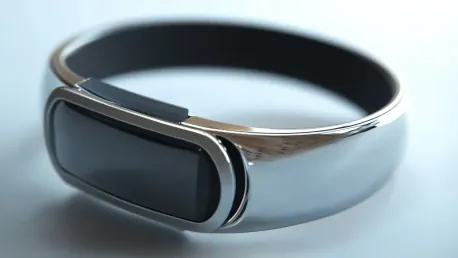Wearable health technology has grown exponentially in recent years, evolving from the simplest devices used to count steps and monitor basic activity levels to highly advanced systems capable of tracking a variety of health indicators. This transformation has made a profound impact on personal health care by offering unprecedented insights into our daily health metrics and overall well-being. These devices not only help in monitoring health but also in providing therapeutic benefits, effectively transforming the landscape of personal health care.
Wearable health tech is now ubiquitous, offering complex insights into various aspects of the user’s health, including sleep patterns, heart rate variability, stress levels, and general activity levels. The convenience of these devices has made them an integral part of many people’s health routines. They’re becoming much more than fitness trackers, integrating advanced technologies such as AI to provide personalized health coaching and real-time feedback, which can lead to more tailored health strategies and significant health improvements over time.
The Evolution of Wearable Health Technology
The journey of wearable health technology began over sixty years ago with the introduction of the manpo-kei, a Japanese pedometer designed to encourage users to achieve 10,000 steps daily. This simple device laid the groundwork for the wearables we see today. Over the years, these devices have transformed from basic step counters into sophisticated gadgets capable of monitoring multiple health parameters. Technological advancements have played a crucial role in this evolution. Early wearables were limited in functionality, but today’s devices can track heart rate, sleep patterns, and even stress levels. This progression has been driven by improvements in sensor technology, data processing, and connectivity, making it possible to gather and analyze a wide range of health data.
As wearables evolved, so did their potential applications. Devices that once provided simple feedback on daily activities now offer detailed analysis and insights into various health metrics. For example, early pedometers gave way to multifunctional fitness trackers capable of monitoring heart rate, tracking sleep patterns, and even detecting abnormal health events. These advancements have been fueled by the continuous improvement of miniaturized sensors, more powerful data processing, and the ability to seamlessly connect to smartphones and cloud-based systems for real-time data analysis and feedback. The foundations laid by early step counters have thus paved the way for today’s comprehensive health monitoring systems, turning wearable technology into essential tools for personal health management.
Current Adoption and Popularity
Wearable health technology is experiencing widespread adoption, with about one-third of American adults using these devices as of 2023. This growing popularity is fueled by the increasing awareness of the importance of health monitoring and the convenience these devices offer. A notable example is entrepreneur Bryan Johnson, who uses multiple wearables, such as WHOOP, to collect extensive health data. These devices provide insights into his sleep patterns, heart rate variability, and overall wellness. Johnson’s example illustrates a growing interest in using data for personal health optimization, highlighting the potential of wearables to transform personal health care.
What sets modern wearable technology apart is its ability to provide detailed, actionable insights on a daily basis. By continuously monitoring various health parameters, these devices help users understand their bodies better and make more informed health decisions. The convenience of having access to real-time health data empowers individuals to take proactive steps towards improving their health and well-being. This trend is not limited to fitness enthusiasts alone; it extends to individuals with chronic conditions who benefit from continuous health monitoring, thereby preventing potential health complications. The seamless integration of these devices into everyday life through applications and platforms that users already frequent also contributes to their widespread adoption and popularity.
Challenges and Innovations in Battery Technology
One of the common challenges for wearable technology is battery life. Users often find the need for frequent charging inconvenient, which can lead to decreased regular use. This issue has prompted significant research and development efforts aimed at improving battery technology. Innovations such as solid-state batteries, which charge quickly and have higher energy density, show promise in addressing this challenge. Other alternative power sources being explored include sweat-activated batteries, flexible films that convert body heat to power, and movement-powered nanogenerators. These advancements could revolutionize wearables by reducing device downtime and encouraging more consistent usage.
The ongoing innovations in battery technology are crucial for the evolution of wearable health tech. Extended battery life means that users can rely on their devices for longer periods without interruption, fostering habit formation and long-term adherence to health monitoring practices. Additionally, the development of alternative power sources not only paves the way for longer battery life but also ensures sustainability. For instance, harnessing body heat or movement to generate power reduces landfill waste from traditional batteries, aligning wearable tech with eco-friendly practices. As these battery technologies mature, they promise not only to enhance the user experience but also to make wearable devices more environmentally sustainable, thereby broadening their appeal and impact.
Expanding Functionality Beyond Fitness Tracking
The functionality of wearable health technology is expanding beyond fitness tracking to include medical biomarker monitoring and therapeutic applications. Future wearables could feature advanced sensors capable of monitoring a wider range of health indicators, such as smart contact lenses for diabetes detection, mouthguards for stress analysis, and t-shirts that can predict heat stroke. Innovations like Bandodkar’s smart bandage, which promotes wound healing using mild electrical currents, represent a shift from merely tracking health metrics to providing therapeutic benefits. These advancements highlight the potential of wearables to play a more active role in health care, offering not just monitoring but also treatment options.
The potential of expanding functionality in wearable health technology is immense and could lead to transformative changes in healthcare delivery and personal health management. With the inclusion of advanced sensors capable of detecting specific biomarkers, wearables can offer early warning systems for various health conditions, allowing for timely interventions and potentially preventing complications. For instance, smart contact lenses that monitor blood sugar levels in real-time can assist diabetes patients in managing their condition more effectively, reducing the risk of severe complications such as hypoglycemia or hyperglycemia. Similarly, wearable devices that monitor stress levels and provide feedback on relaxation techniques can improve mental health, offering holistic health benefits beyond physical fitness.
The Role of Artificial Intelligence in Wearables
As wearable devices become more advanced, the complexity of the data they collect increases. Interpreting this information effectively is critical, and this is where artificial intelligence (AI) comes into play. AI has become essential in helping users make sense of the vast amounts of data their devices generate. WHOOP’s collaboration with OpenAI to develop WHOOP Coach is a prime example. This AI-driven virtual coach interprets wearable data and provides personalized health and fitness advice. Similar developments from companies like Apple and Samsung indicate a significant trend toward incorporating AI into wearable technology for enhanced user support and personalized recommendations.
Incorporating AI into wearable health technology has the potential to revolutionize personalized health management. AI algorithms can analyze vast amounts of data and identify patterns that may not be apparent to the user or even to healthcare professionals. By providing real-time feedback and personalized recommendations, AI can help users optimize their health and wellness strategies. For example, an AI-driven wearable can analyze sleep patterns and suggest personalized interventions to improve sleep quality. Moreover, AI can predict potential health issues based on long-term data analysis, providing users with early warnings and preventive health advice. The integration of AI thus enhances the utility of wearable devices, making them powerful tools for proactive health management.
The Future of Wearable Health Technology
Wearable health technology is evolving rapidly, moving beyond mere fitness tracking to encompass medical biomarker monitoring and therapeutic applications. The future of these wearables could include advanced sensors capable of tracking a broader spectrum of health indicators. Imagine smart contact lenses that detect diabetes, mouthguards that analyze stress levels, or t-shirts designed to predict heat stroke before it happens. Innovations like Bandodkar’s smart bandage, which aids wound healing through mild electrical currents, signify a transformative shift from solely tracking health metrics to providing direct therapeutic benefits. This progress shows wearables’ potential to take a more proactive role in healthcare, offering not just monitoring but also treatment solutions.
These advancements in wearable health technology hold immense potential to transform healthcare delivery and personal health management. By integrating advanced sensors that detect specific biomarkers, wearables can function as early warning systems for various health conditions. For example, smart contact lenses that monitor real-time blood sugar levels could help diabetes patients manage their condition more effectively, reducing the risk of complications like hypoglycemia or hyperglycemia. Similarly, wearables that monitor stress and offer feedback on relaxation techniques can enhance mental well-being. This demonstrates that wearables can provide holistic health benefits, extending their impact beyond just physical fitness.









